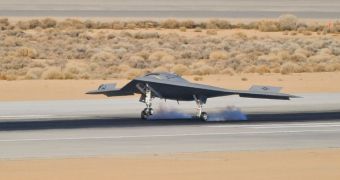Engineers from the leading military contractor Northrop Grumman and the United States Navy announce the successful completion of a series of tests, meant to prove that the newly-developed X-47B Unmanned Combat Aerial Vehicle (UCAV) can be operated from aircraft carriers.
The X-47B – developed from the X-47A Pegasus – took its first flight on February 4, 2011, but the corporation is already moving fast to ensure that all combat platforms can operate the aircraft.
Using the USS Dwight D. Eisenhower, the second of ten ships in the Nimitz class of supercarriers, was used as a testbed for a new ship-based software that operated the unmanned airplane. Related systems were also checked, using a manned surrogate vehicle.
Operating the UCAV from aircraft carriers would significantly contribute to improving the performance of US military personnel in foreign combat theaters, such as for example Iraq and Afghanistan. The X-47B could operate alongside the established Predators and other unmanned drones.
During the flight tests, the surrogate aircraft was fitted with the same precision navigation control software that is installed on the unmanned aircraft. The pilot then carried out maneuvers on the deck of the Eisenhower, and also took off and landed several times.
“This manned surrogate test event is a significant and critical step toward landing the X-47B on the carrier deck in 2013,” explains the manager of the US Navy Unmanned Combat Air System (N-UCAS) program, Capt. Jaime Engdahl. The tests took place on July 2, in the western Atlantic Ocean.
“It represents the first end-to-end test of the hardware and software systems that will eventually allow unmanned systems to integrate safely and successfully with all aspects of carrier operations,” he adds.
The successful completion of the maneuvers was made possible by the strong and close collaborative efforts made by engineers at the US Naval Air Systems Command (NAVAIR) and Northrop Grumman.
“The precision navigation and control capability demonstrated by the UCAS-D team represents a potential 'breakthrough' capability for the Navy,” says the Northrop Grumman Aerospace Systems N-UCAS vice-president, Janis Pamiljans.
“It could be applied, in theory, to any manned or unmanned carrier-compatible aircraft, which could have a dramatic effect on the tempo and efficiency of future carrier operations,” he goes on to say.
In standard aircraft, pilots and air operations personnel on the ship communicate with each other before landing. The main challenge associated with UAV landings on aircraft carriers is allowing the two to communicate directly, eliminating human interference.
This can also ensure that corrections are made on the fly, and that errors are kept to a minimum. At the same time, computers on the ship and on the UAV can communicate a lot more data than can be handled by a highly-trained team of human operators.

 14 DAY TRIAL //
14 DAY TRIAL //